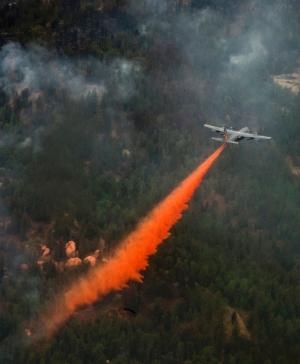Wed, Jun 26, 2013
Two Additional MAFF Aircraft From California Assist In Fire Suppression Effort
Two additional Modular Airborne Fire Fighting System-equipped military C-130 Hercules are joining the battle against wildland fires in Colorado. The U.S. Forest Service requested the additional aircraft through the National Interagency Fire Center in Boise, ID.

Two aircraft from the California Air National Guard's 146th Airlift Wing, based in Port Hueneme, CA, deployed Sunday to Peterson Air Force Base in Colorado Springs, CO. They join two C-130s from Air Force Reserve Command's 302nd Airlift Wing, based at Peterson AFB, which have been engaged in aerial firefighting for more than a week.
The two California aircraft bring the MAFFS fleet to four airplanes.
The request is in response to an increase in wildland fire activity in southern Colorado and neighboring states and the significant fire potential forecast for the coming week, officials said.
MAFFS initially activated June 11 to assist in fighting forest fires in southern Colorado after the Forest Service sent a request for assistance to the Defense Department through U.S. Northern Command. Since activating, MAFFS aircraft have made 36 drops using 93,830 gallons of fire retardant. MAFFS is a self-contained aerial firefighting system owned by the Forest Service. MAFFS modules are loaded into the cargo bays of military C-130 aircraft.
Led by small Forest Service planes, military aircrews can discharge 3,000 gallons of water or fire retardant from the MAFFS modules along the leading edge of a forest fire in less than five seconds and cover an area a quarter of a mile long by 100 feet wide. Once the load is discharged, ground crews at a MAFFS tanker base can refill the modules in less than 12 minutes.
A joint DOD and Forest Service program, MAFFS provides aerial firefighting resources when commercial and private air tankers are no longer able to meet the Forest Service's needs. A provisional military air expeditionary group controls the MAFFS resources at the Forest Service's direction.
(Image provided by the USAF)
More News
Aero Linx: Model Aeronautical Association of Australia MAAA clubs are about fun flying, camaraderie and community. For over 75 years, the MAAA has been Australia’s largest fl>[...]
Touchdown Zone Lighting Two rows of transverse light bars located symmetrically about the runway centerline normally at 100 foot intervals. The basic system extends 3,000 feet alon>[...]
“Discovery and innovation are central to our mission at Virgin Galactic. We’re excited to build on our successful record of facilitating scientific experiments in subor>[...]
How To Get A Story On Aero-TV News/Feature Programming How do I submit a story idea or lead to Aero-TV? If you would like to submit a story idea or lead, please contact Jim Campbel>[...]
Student Pilot Reported That During Rotation, “All Of A Sudden The Back Of The Plane Kicked To The Right..." Analysis: The student pilot reported that during rotation, “>[...]
 ANN's Daily Aero-Linx (05.02.24)
ANN's Daily Aero-Linx (05.02.24) ANN's Daily Aero-Term (05.02.24): Touchdown Zone Lighting
ANN's Daily Aero-Term (05.02.24): Touchdown Zone Lighting Aero-News: Quote of the Day (05.02.24)
Aero-News: Quote of the Day (05.02.24) ANN FAQ: Contributing To Aero-TV
ANN FAQ: Contributing To Aero-TV NTSB Final Report: Cirrus Design Corp SR20
NTSB Final Report: Cirrus Design Corp SR20



